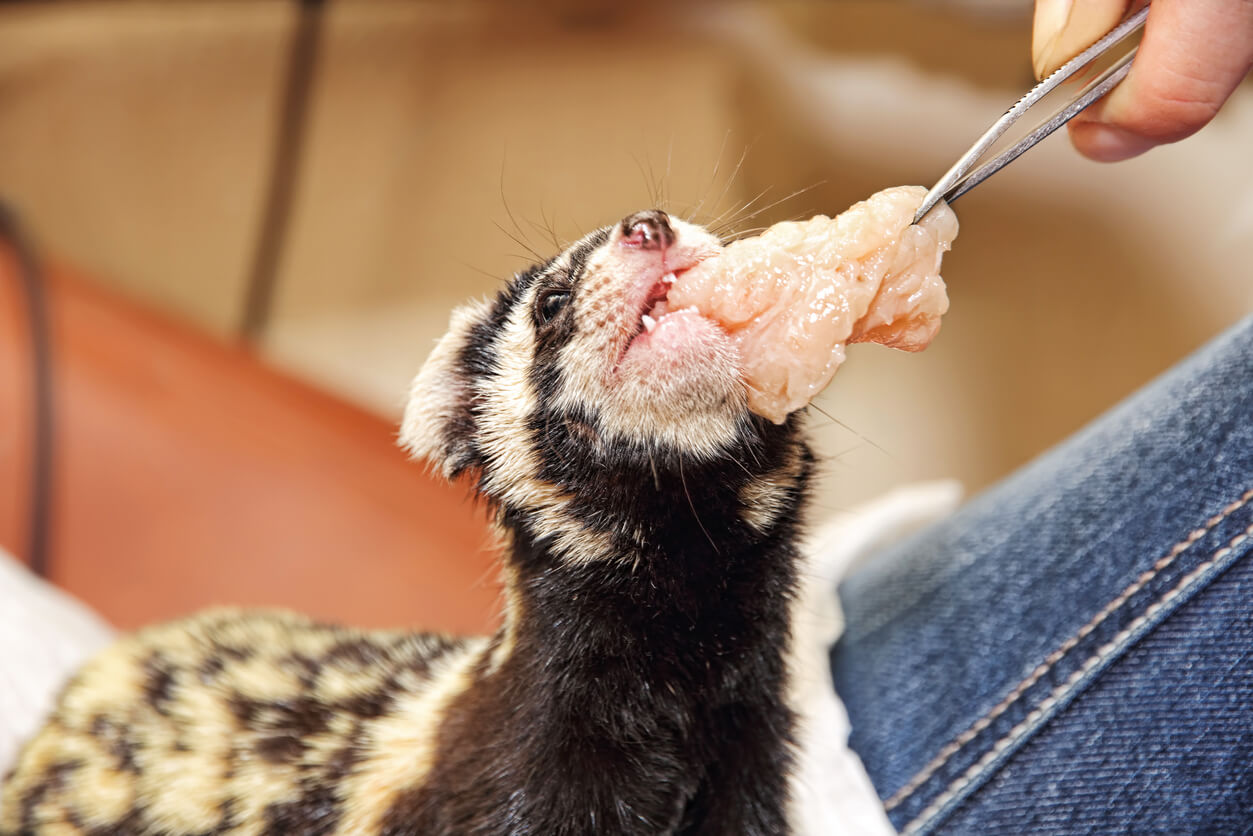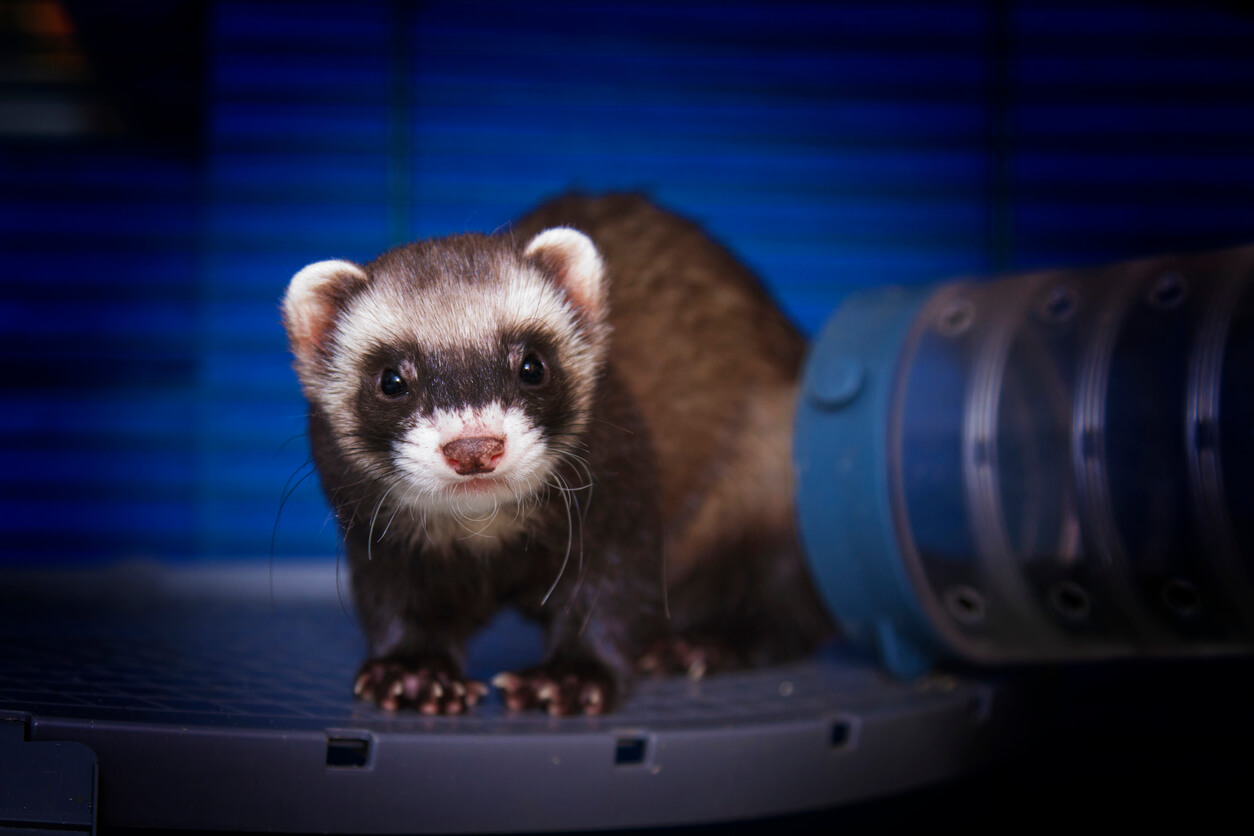How to Create the Ideal Home for Your Ferret

These adorable little mammals have stolen the hearts of millions of people who see them as the perfect pets. So, it’s not surprising that their popularity is growing and they’re arousing the curiosity of new owners. So, if you plan to adopt one soon, keep reading to learn how to create the ideal home for your ferret.
Ferrets (Mustela putorius furo) are friendly, curious, and playful animals. However, caring for them can be a challenge for those who are unfamiliar with their needs. Although they’re easy to keep, they require several measures to make them feel comfortable and have everything they need close at hand. In that regard, certain recommendations for their care should be followed.
Guide to making the ideal home for your ferret
Nowadays, there are many people who prefer to adopt an exotic animal as a pet to give it their love and attention. Among the most popular options, ferrets stand out, thanks to the fact that they’re not only sociable and active companions, but also very cute and intelligent. With these simple steps, you’ll know what to keep in mind to provide the best possible space for these beautiful creatures.
1. Buy a large cage and choose a suitable location
The first step is to choose a quiet and safe place in your home where you can place the cage of your ferret. It should be a place that’s free of drafts and away from direct sunlight and heat sources. In addition, there should be no dangerous or toxic objects within reach of your pet. Keep in mind the following recommendations.
1. Size: When purchasing the cage, make sure it’s spacious so that your ferret can move freely and exercise. The minimum recommended size is 75 x 45 x 60 cm. But if you have a couple of ferrets, you’ll need a larger cage.
2. Material: It’s preferable to buy a metal cage with a solid base. It should also have horizontal bars so that your ferret can climb, but not too far apart, to prevent your pet from escaping or getting stuck.
3. Accessories: The cage should have a litter box, a water fountain, a feeder, and some toys for your ferret to entertain itself. You can also include a play tube and a hammock, as these animals love to climb and sleep in high places.
2. Find out about their nutrition and hydration

These mammals are strict carnivores and need a diet rich in animal protein. A proper diet should include a variety of meats: Chicken, beef, lamb; dry and wet foods specific for ferrets, as well as small amounts of fruits and vegetables.
Avoid giving them cat or dog products, as these don’t contain the nutrients to meet their needs. You should prioritize meats over concentrates.
Also, when you’re creating the ideal home for your ferret, make sure it has access to fresh water at all times. Installing a drinking fountain and filling it with clean water every day is a must.
3. Take care of your ferret’s grooming and hygiene
Like all animals, ferrets need a clean space to maintain their health and avoid diseases, so clean the litter tray every day and disinfect the accessories once a week.
Likewise, owners must learn how to maintain their pet’s hygiene. For example, the skin of these friends produces natural oils that protect them. So, you should bathe them only when necessary, such as when they get dirty with their fecal matter or if they have a strong odor.
You can use a specific shampoo and make sure to rinse it well. To keep their coat shiny, brush them regularly to prevent hairballs from forming. And don’t forget to trim their nails and gently clean their ears.
4. Provide the necessary medical care

When you decide to create the ideal home for your ferret, besides the size of the cage or the number of toys you buy, you must ensure its health and safety at all times. So, when you adopt one, remember that it’s your obligation to vaccinate it against deadly diseases such as distemper and canine rabies.
Ferrets are susceptible to parasites, such as fleas, ticks, and worms. Therefore, use specific anti-parasitic products and follow the instructions carefully. If your pet shows symptoms such as lethargy, loss of appetite, or behavioral changes, take it to your nearest veterinary center immediately.
5. Strengthens ferrets’ socialization
A study published in the journal Applied Animal Behaviour Science reported that good socialization is crucial for ferrets to live harmoniously in a human environment.
So, spend time interacting and doing daily activities with them, give them rewards (food) when they do something well, and provide comfortable spaces for them to rest and hide. This can help prevent behavioral problems.
Provide the ideal home for your ferret and take care of its welfare
In conclusion, these animals can be very sociable and lovable pets. So, to create the ideal home for your ferret, you should pay attention to their space, feeding, grooming, medical care, and disease prevention.
Remember that these little creatures also need love, attention, and companionship, so be sure to spend time playing and interacting with them every day. With basic care, your ferret can be a loyal companion for many years to come.
These adorable little mammals have stolen the hearts of millions of people who see them as the perfect pets. So, it’s not surprising that their popularity is growing and they’re arousing the curiosity of new owners. So, if you plan to adopt one soon, keep reading to learn how to create the ideal home for your ferret.
Ferrets (Mustela putorius furo) are friendly, curious, and playful animals. However, caring for them can be a challenge for those who are unfamiliar with their needs. Although they’re easy to keep, they require several measures to make them feel comfortable and have everything they need close at hand. In that regard, certain recommendations for their care should be followed.
Guide to making the ideal home for your ferret
Nowadays, there are many people who prefer to adopt an exotic animal as a pet to give it their love and attention. Among the most popular options, ferrets stand out, thanks to the fact that they’re not only sociable and active companions, but also very cute and intelligent. With these simple steps, you’ll know what to keep in mind to provide the best possible space for these beautiful creatures.
1. Buy a large cage and choose a suitable location
The first step is to choose a quiet and safe place in your home where you can place the cage of your ferret. It should be a place that’s free of drafts and away from direct sunlight and heat sources. In addition, there should be no dangerous or toxic objects within reach of your pet. Keep in mind the following recommendations.
1. Size: When purchasing the cage, make sure it’s spacious so that your ferret can move freely and exercise. The minimum recommended size is 75 x 45 x 60 cm. But if you have a couple of ferrets, you’ll need a larger cage.
2. Material: It’s preferable to buy a metal cage with a solid base. It should also have horizontal bars so that your ferret can climb, but not too far apart, to prevent your pet from escaping or getting stuck.
3. Accessories: The cage should have a litter box, a water fountain, a feeder, and some toys for your ferret to entertain itself. You can also include a play tube and a hammock, as these animals love to climb and sleep in high places.
2. Find out about their nutrition and hydration

These mammals are strict carnivores and need a diet rich in animal protein. A proper diet should include a variety of meats: Chicken, beef, lamb; dry and wet foods specific for ferrets, as well as small amounts of fruits and vegetables.
Avoid giving them cat or dog products, as these don’t contain the nutrients to meet their needs. You should prioritize meats over concentrates.
Also, when you’re creating the ideal home for your ferret, make sure it has access to fresh water at all times. Installing a drinking fountain and filling it with clean water every day is a must.
3. Take care of your ferret’s grooming and hygiene
Like all animals, ferrets need a clean space to maintain their health and avoid diseases, so clean the litter tray every day and disinfect the accessories once a week.
Likewise, owners must learn how to maintain their pet’s hygiene. For example, the skin of these friends produces natural oils that protect them. So, you should bathe them only when necessary, such as when they get dirty with their fecal matter or if they have a strong odor.
You can use a specific shampoo and make sure to rinse it well. To keep their coat shiny, brush them regularly to prevent hairballs from forming. And don’t forget to trim their nails and gently clean their ears.
4. Provide the necessary medical care

When you decide to create the ideal home for your ferret, besides the size of the cage or the number of toys you buy, you must ensure its health and safety at all times. So, when you adopt one, remember that it’s your obligation to vaccinate it against deadly diseases such as distemper and canine rabies.
Ferrets are susceptible to parasites, such as fleas, ticks, and worms. Therefore, use specific anti-parasitic products and follow the instructions carefully. If your pet shows symptoms such as lethargy, loss of appetite, or behavioral changes, take it to your nearest veterinary center immediately.
5. Strengthens ferrets’ socialization
A study published in the journal Applied Animal Behaviour Science reported that good socialization is crucial for ferrets to live harmoniously in a human environment.
So, spend time interacting and doing daily activities with them, give them rewards (food) when they do something well, and provide comfortable spaces for them to rest and hide. This can help prevent behavioral problems.
Provide the ideal home for your ferret and take care of its welfare
In conclusion, these animals can be very sociable and lovable pets. So, to create the ideal home for your ferret, you should pay attention to their space, feeding, grooming, medical care, and disease prevention.
Remember that these little creatures also need love, attention, and companionship, so be sure to spend time playing and interacting with them every day. With basic care, your ferret can be a loyal companion for many years to come.
All cited sources were thoroughly reviewed by our team to ensure their quality, reliability, currency, and validity. The bibliography of this article was considered reliable and of academic or scientific accuracy.
- Fox, J. G., Schultz, C. S., & Vester Boler, B. M. (2014). Nutrition of the Ferret. Biology and Diseases of the Ferret, 123-143. https://onlinelibrary.wiley.com/doi/abs/10.1002/9781118782699.ch5
- Hernádi, A., Kis, A., Turcsán, B., & Topál, J. (2012). Man’s underground best friend: domestic ferrets, unlike the wild forms, show evidence of dog-like social-cognitive skills. https://journals.plos.org/plosone/article?id=10.1371/journal.pone.0043267
- Vinke, C. M., & Schoemaker, N. J. (2012). The welfare of ferrets (Mustela putorius furo T): A review on the housing and management of pet ferrets. Applied Animal Behaviour Science, 139(3-4), 155-168. https://www.sciencedirect.com/science/article/abs/pii/S0168159112000998
This text is provided for informational purposes only and does not replace consultation with a professional. If in doubt, consult your specialist.








